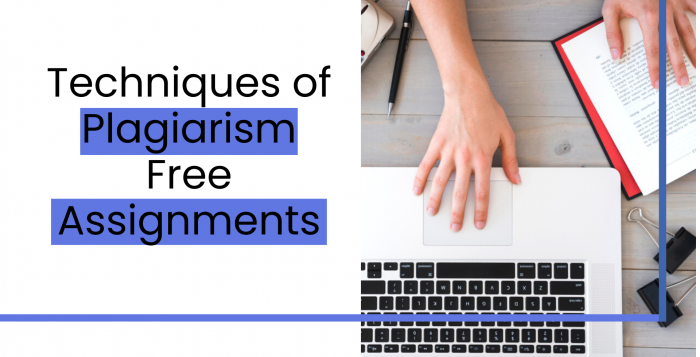Techniques of Plagiarism Free Assignments
No matter how much you dread the assignment writing task, it is the only way to improve your grades and overall academic performance. Sadly, many students fail to understand that the writing task is for testing their creativity and researching skills. Yet, they end up submitting copied and pasted content instead of an original piece. And when asked, they have multiple explanations for each. Some say that they did it because of a tight deadline while others say they had a bundle of assignments to look after.
So, if you are in a similar situation, know that composing a copy-pasted assignment is not the answer. Without worrying, you can easily come up with an exceptionally well-versed paper that is non-plagiarised and up to the standard. But first, you need to understand what plagiarism is.
What is Plagiarism?
The concept of plagiarism is to detect another author’s content that you have used as your own. In simpler words, it is the copying and pasting of someone else’s work without giving them proper credits. Therefore, you need to understand that by doing so, you not only undermine the strength of your paper and lose grades as well.
In academic writing, there are three types of plagiarism.
• First is when you steal someone’s ideas and present it as your own without acknowledging the source.
• Second is when you rephrase the content and include it in your work without mentioning the source used.
• Lastly, when you incorporate ideas from a known source and do not give the due credits in the end.
Why is Plagiarism Discouraged?
Before we go in depth to understand the plagiarism, you should know that there are strict policies regarding plagiarism in academic institutes. The doer has to face severe consequences and might end up with an F grade or cancellation of the entire paper or assignment if the content of the task is found plagiarised.
To answer your question, why is plagiarism not favoured, you should know that:
• Plagiarism cancels out your chance to be creative.
• Plagister’s knowledge and abilities become limited.
• It takes away the opportunity from the real writer to be successful.
• Most of the institutes put a permanent plagiarised-content badge on the transcript or blacklist you, which would make you suffer in your professional career.
Remember, plagiarised content is a form of threat as you are stealing someone’s content. So, even if you are running behind your schedule for a tight deadline, do not opt for plagiarism. Make sure you take idea and come up with a unique content piece for your assignments. To help you form a unique piece, here are a few ways you can avoid plagiarism.
Ways to Avoid Plagiarism
We have often seen students requiring law assignment help to form a law assignment or coursework to avoid plagiarism. Just like law students, there are several students belonging to countless other disciplines asking for help from online academic professional service providers. For this reason, we have covered a few steps to help you come up with 100% original pieces.
1. Jot Down Your Thoughts First
You may have experienced that when you start researching about the topic, you have a cloud of thoughts in your mind. But once you start indicting it, you can’t seem to construct a simple theory. Here, a pre-planned structure of the content can help you begin your task. It sets a vivid image of the content that you are supposed to include in your assignment.
Remember, the clearer the image, the lesser the plagiarised content. Thus, start by penning down your first thoughts and the ideas that you like from other authors. Ensure you follow all the rules and standards of academic writing to get the grades you deserve.
2. Ensure Proper Paraphrasing
First and foremost, every student needs to learn the art of paraphrasing. It doesn’t in anyway mean you are stealing someone else’s work. The purpose is to take the idea of the context and present it in your own words. However, when you do this, you need to make sure the content you are referring to is authentic and itself non-plagiarised.
For this, there are several paraphrasing tools found on the internet. But you cannot fully rely on them as it only replaces specific words and phrases. So, it is better to be your own knight in the shining armour and use synonyms, indirect speech, rephrase or explain the content in a different way to avoid plagiarism.
3. Give Credits When Due
There are two ways to give credits when you include other author’s work in your document. One way is to cite the source or give reference to it.
Citation – even though it is a single word but the assessment of your assignment depends on it. When you cite an article or paper, you acknowledge other author’s work and tell the reader that you’ve made an effort to create plagiarism-free content. However, there are various ways to give credits depending on your institute and the professors. You can either use Oxford, MLA, APA or Harvard to avoid plagiarism.
On the other hand, referencing means including the page number(s), journal name(s), version number(s), author(s) name, web page(s) and all the relevant information about the cited source at the end of the document. By doing so, not only you impress your instructor, but also strengthen the assignment’s worth and quality.
4. Use Plagiarism Checking Tool
Plagiarism checking tools come in handy when you have to submit your final essay or a research article in a journal. This system checks the percentage of the copied content in your paper so that you can change it before the submission. In case your assignment does have plagiarism, it provides you with the list of sources you have taken the content from. You can go back to the links and paraphrase the paragraph accordingly. The rectification allows you to submit your work without the fear of plagiarism and ensures good grades.
5. Edit and Revise the Paper
Once you have completed writing the assignment, you need to go through the content again to ensure you have followed all the guidelines. Your finished document should be up to the standards and free of all kinds of errors and mistakes. Moreover, sometimes it happens that you diverge from your writing style and adopt the tone you were citing from. Thus, it ends you up with plagiarised content.
To avoid this, it is necessary to always find your voice and stick to your ideas and structure. It not only makes paper production smooth but also ensures with non-plagiarised content, the paper is error-free as well.
6. Take Professional Help
If you think you are stuck somewhere and there is no option left but to copy the content, stop right there. Your professors or experts from the writing field can help you find ways that allow you to present the ideas as your own. They can also guide you in better understanding the meaning behind the topic and clear any queries that may arise with time.
The Bottom Line
Assignment writing is a task where plagiarism is not taken for granted, but is a serious offence. Broadly speaking, plagiarism cannot be fully eradicated from your student life. However, you can take measures such as including these 6 simple tips for an original content. In the end, you will be surprised to see the finished assignment to be unique and plagiarism-free.



